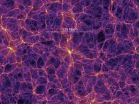(Press-News.org) RIVERSIDE, Calif. - How do galaxies like our Milky Way form, and just how do they evolve? Are galaxies affected by their surrounding environment? An international team of researchers, led by astronomers at the University of California, Riverside, proposes some answers.
The researchers highlight the role of the "cosmic web" - a large-scale web-like structure comprised of galaxies - on the evolution of galaxies that took place in the distant universe, a few billion years after the Big Bang. In their paper, published Nov. 20 in the Astrophysical Journal, they present observations showing that thread-like "filaments" in the cosmic web played an important role in this evolution.
"We think the cosmic web, dominated by dark matter, formed very early in the history of the universe, starting with small initial fluctuations in the primordial universe," said Behnam Darvish, a Ph.D. graduate student in the Department of Physics and Astronomy at UC Riverside, who led the research project and is the first author on the paper. "Such a 'skeletal' universe must have played, in principle, a role in galaxy formation and evolution, but this was incredibly hard to study and understand until recently."
The distribution of galaxies and matter in the universe is non-random. Galaxies are organized, even today, in a manner resembling an enormous network - the cosmic web. This web has dense regions made up of galaxy clusters and groups, sparsely populated regions devoid of galaxies, as well as the filaments that link overdense regions.
"The filaments are like bridges connecting the denser regions in the cosmic web," Darvish explained. "Imagine threads woven into the web."
Videos showing structures in the cosmic web:
http://www.mpa-garching.mpg.de/galform/data_vis/millennium_sim_1024x768.avi [Credit: Springel et al. (Virgo Consortium)]
http://vimeo.com/36095013 [Credit: Miguel Aragon-Calvo]
http://www.mpa-garching.mpg.de/galform/data_vis/g696_mpeg4.avi [Credit: Klaus Dolag]
http://www.mpa-garching.mpg.de/galform/data_vis/g696_fast_mpeg4.avi [Credit: Klaus Dolag]
It is well known in astronomy that galaxies residing in less dense regions have higher probability of actively forming stars (much like our Milky Way), while galaxies in denser regions form stars at a much lower rate.
"But the role of intermediate environments and, in particular, the role of filaments and the cosmic web in the early universe remained, until very recently, a mystery," said coauthor Bahram Mobasher, a professor of physics and astronomy at UCR and Darvish's adviser.
What greatly assisted the researchers is a giant section of the cosmic web first revealed in two big cosmological surveys (COSMOS and HiZELS). They proceeded to explore data also from several telescopes (Hubble, VLT, UKIRT and Subaru). They then applied a new computational method to identify the filaments, which, in turn, helped them study the role of the cosmic web.
They found that galaxies residing in the cosmic web/filaments have a much higher chance of actively forming stars. In other words, in the distant universe, galaxy evolution seems to have been accelerated in the filaments.
"It is possible that such filaments 'pre-process' galaxies, accelerating their evolution while also funneling them towards clusters, where they are fully processed by the dense environment of clusters and likely end up as dead galaxies," Darvish said. "Our results also show that such enhancement/acceleration is likely due to galaxy-galaxy interactions in the filaments."
Because of the complexities involved in quantifying the cosmic web, astronomers usually limit the study of the cosmic web to numerical simulations and observations in our local universe. However, in this new study, the researchers focused their work on the distant universe - when the universe was approximately half its present age.
"We were surprised by the crucial role the filaments play in galaxy formation and evolution," Mobasher said. "Star formation is enhanced in them. The filaments likely increase the chance of gravitational interaction between galaxies, which, in turn, results in this star-formation enhancement. There is evidence in our local universe that this process in filaments also continues to occur at the present time."
Darvish and Mobasher were joined in this research by L. V. Sales at UCR; David Sobral at the Universidade de Lisboa, Portugal; N. Z. Scoville at the California Institute of Technology; P. Best at the Royal Observatory of Ediburgh, United Kingdom; and I. Smail at Durham University, United Kingdom.
Next, the team plans to extend this study to other epochs in the age of the universe to study the role of the cosmic web/filaments in galaxy formation and evolution across cosmic time.
"This will be a fundamental piece of the puzzle in order to understand how galaxies form and evolve as a whole," Sobral said.
INFORMATION:
The UCR researchers were supported in the study by a grant to Mobasher from NASA through the Space Telescope Science Institute.
The University of California, Riverside (http://www.ucr.edu) is a doctoral research university, a living laboratory for groundbreaking exploration of issues critical to Inland Southern California, the state and communities around the world. Reflecting California's diverse culture, UCR's enrollment has exceeded 21,000 students. The campus opened a medical school in 2013 and has reached the heart of the Coachella Valley by way of the UCR Palm Desert Center. The campus has an annual statewide economic impact of more than $1 billion. A broadcast studio with fiber cable to the AT&T Hollywood hub is available for live or taped interviews. UCR also has ISDN for radio interviews. To learn more, call (951) UCR-NEWS.
BOSTON (Nov. 20, 2014) Investigators at Massachusetts Eye and Ear and Harvard Medical School Department of Ophthalmology and colleagues reported the development and characterization of a comprehensive genetic test for inherited eye disorders in the online version of the Nature journal Genetics In Medicine today. The Genetic Eye Disease (GEDi) test includes all of the genes known to harbor mutations that cause inherited retinal degenerations, optic atrophy and early onset glaucoma. These disorders are important causes of vision loss, and genetic treatments such as gene ...
DURHAM, N.C. -- Displaced political aides looking for a new, nonpartisan job in the wake of the midterm power shuffle may fare better if they tone down any political references on their resumes, finds a new study from Duke University.
The study found that applicants who shared the minority partisan view of voters where a resume was sent were less likely to receive a callback from an employer than a candidate with a neutral resume.
Sharing information in line with the majority partisan view didn't give candidates an advantage, however.
"Our results showed that individuals ...
A new study from UNC's Frank Porter Graham Child Development Institute (FPG) reveals that disruptions in child care negatively affect children's social development as early as age 4. However, the study also shows that the effects of child care instability are not unduly large--and some types of instability appear to have no negative impact on children.
"Our findings showed that when young children moved between child care settings, these transitions negatively affected their social adjustment," said FPG investigator Mary Bratsch-Hines. "But when children had a history ...
The research found that incisor teeth grow quickly in the early stages of the second trimester of a baby's development, while molars grow at a slower rate in the third trimester. This is so incisors are ready to erupt after birth, at approximately six months of age, when a baby makes the transition from breast-feeding to weaning.
Weaning in humans takes place relatively early compared to some primates, such as chimpanzees. As a result, there is less time available for human incisors to form, so the enamel grows rapidly to compensate.
This research can increase our understanding ...
New Rochelle, NY, November 20, 2014-Women are more sensitive to the effects of cocaine and more susceptible to cocaine abuse than men. Cocaine's ability to disrupt a woman's estrus cycle may explain the sex differences in cocaine addiction, and new evidence that caffeine may be neuroprotective and able to block cocaine's direct effects on the estrus cycle reveals novel treatment possibilities, according to an article published in Journal of Caffeine Research: The International Multidisciplinary Journal of Caffeine Science, a peer-reviewed journal from Mary Ann Liebert, ...
Birds that are related, such as Darwin's finches, but that vary in beak size and behavior specially evolved to their habitat are examples of a process called speciation. It has long been thought that dramatic changes in a landscape like the formation of the Andes Mountain range or the Amazon River is the main driver that initiates species to diverge. However, a recent study shows that speciation occurred much later than these dramatic geographical changes. Researchers from LSU's Museum of Natural Science have found that time and a species' ability to move play greater parts ...
The higher your level of education, the greater your earnings and your sense of "personal mastery" or being in control of your fate, University of Toronto researchers say. But wait: there's a downside.
Professor Scott Schieman, Canada Research Chair in the Social Contexts of Health, and PhD student Atsushi Narisada investigated the adverse effects associated with attaining a high degree of mastery. Using the Canadian Work, Stress, and Health Study (CANWSH), a national sample of Canadian workers, the researchers measured proficiency, or mastery, by asking study participants ...
Thanks to the NASA/ESA Hubble Space Telescope, some of the most mysterious cosmic residents have just become even more puzzling. New observations of globular clusters in a small galaxy show they are very similar to those found in the Milky Way, and so must have formed in a similar way. One of the leading theories on how these clusters form predicts that globular clusters should only be found nestled in among large quantities of old stars. But these old stars, though rife in the Milky Way, are not present in this small galaxy, and so, the mystery deepens.
Globular clusters ...
Modern hand dryers are much worse than paper towels when it comes to spreading germs, according to new University of Leeds research.
Scientists from the University of Leeds have found that high-powered 'jet-air' and warm air hand dryers can spread bacteria in public toilets. Airborne germ counts were 27 times higher around jet air dryers in comparison with the air around paper towel dispensers.
The study shows that both jet and warm air hand dryers spread bacteria into the air and onto users and those nearby.
The research team, led by Professor Mark Wilcox of the ...
PharmaMar results for antitumoral compounds and their mechanism of action at EORTC-NCI-AACR emphasize an innovative pipeline of targeted therapies
Targeting of eEF1A2 by antitumor drug Aplidin® reveals novel mechanism of action driving therapeutic efficacy
A newly developed antibody-drug conjugate (ADC) combining a marine-derived agent with trastuzumab shows potent antitumoral activity in breast tumors overexpressing HER2 grown in mice
Antitumoral activity of investigational drugs with different molecular targets in the pipeline highlights their potential ...






